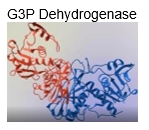So in our last lesson video, we said that the tertiary structure is primarily stabilized by our group interactions and not by backbone interactions. Most of these R group interactions that stabilize tertiary structure are non-covalent interactions. There are actually 4 non-covalent interactions that you guys should be familiar with, numbered 1, 2, 3, and 4 down below. The first non-covalent interaction you should know is ionic bonding, and ionic bonds are also known as salt bridges. The second non-covalent interaction is the hydrophobic effect, which we also covered in our previous lesson videos. The third is hydrogen bonding, and the fourth is actually van der Waals interactions.
Although most of the R group interactions stabilizing tertiary structure are non-covalent, there are some covalent R group interactions that can stabilize tertiary structure. Two cysteine amino acids can react and link to form a cysteine residue containing a single disulfide bond. Essentially, disulfide bonds are our 5th type of R group interaction, but this is a covalent type of R group interaction. Disulfide bridges are a type of covalent R group interaction that could potentially stabilize the overall 3D structure or the tertiary structure.
In our image below, we're going to talk about, and give examples of each of these types of bonds. First, what you'll notice is this long, orange-looking rope thing right here is essentially our peptide backbone. Notice that the peptide backbone is capable of folding, so notice that it's not linear; it actually folds into different patterns. We're going to talk more about protein folding a little later in our course, but it's important to note that protein folding allows for amino acids that are distant in sequence to be put closer into proximity so that their R groups can interact, and we'll be able to see that down below as well.
We know that ionic bonds are also known as salt bridges and can only form between R groups that are ionizable. Recall that our mnemonic for memorizing the 7 amino acids with ionizable R groups is "just yucky crazy dragons eat knights riding horses". These are the 7 amino acids that are ionizable and those are the ones that are capable of forming ionic bonds. In this example here, you can see that we have two ionizable R groups, we have lysine’s R group right here and then on the other side what we have is aspartic acid's R group.
Our second type of non-covalent interaction is the hydrophobic effect. We can see the hydrophobic effect occurring between these two nonpolar amino acids, more specifically these two valine amino acids. The hydrophobic effect essentially allows these two non-polar valine amino acid R groups to clump together, as we see here.
Our third non-covalent interaction is the hydrogen bond. Hydrogen bonding can really occur between any amino acid R group that can form a hydrogen bond, but typically we'll see that these are the polar amino acid R groups. Here you can see that we have a serine R group right here, which is one of our polar amino acids, and then we also have asparagine's R group, and both of these R groups are polar and they're forming a hydrogen bond with one another.
Notice that we do not actually have a fourth number for the van der Waals interactions because the van der Waals interactions occur between all atoms. The van der Waals interactions are occurring between all portions of our polypeptide chain. You can imagine that the van der Waals interactions are occurring between these two separate chains here to keep them in close proximity. Overall, they have a large impact on providing tertiary structure to our protein. But because they occur throughout our entire chain, we don't have them numbered in a, one particular point.
Now, our fifth and final type of R group interaction is actually a covalent R group interaction, and that is our disulfide bridge. You can see that the disulfide bridge essentially forms between two cysteine amino acids to form the disulfide bond that's shown in red between these two sulfurs, and we can see that a little bit better over here on the image on the right.
You can see what we have are two cysteine amino acids, on the left hand portion over here, so you can see here's one cysteine amino acid and here’s the other. Recall that cysteine spends a lot of time in the cysteine chapel and whenever somebody makes a noise, cysteine is like, shhh. So, cysteine is really just alanine with an SH group coming off. Together, all five of these R group interactions contribute to the tertiary structure of proteins.
This concludes our lesson on the tertiary structure of proteins and the R group interactions, and we'll be able to get some practice in our next couple of videos. So, I'll see you guys there.



